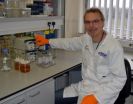(Press-News.org) Orang-utans come down from the trees and spend more time on the ground than previously realised – but this behaviour may be partly influenced by man, a new study has found.
Dr Mark Harrison, based in the Department of Geography at the University of Leicester and Managing Director of the Orang-utan Tropical Peatland Project (OuTrop) has, along with international colleagues, published results of a seven year study of orang-utans in Borneo in the journal Scientific Reports.
The research, conducted between June 2006 and March 2013, is based on a large-scale analysis of orang-utan terrestriality using comprehensive camera-trapping data from 16 sites across Borneo. In total there were 641 independent orang-utan records taken at 1,409 camera trap stations over 159,152 trap days.
The Bornean orang-utan (Pongo pygmaeus) is the world's largest arboreal (tree-dwelling) mammal. Records of terrestrial behaviour are rare and tend to be associated with habitat disturbance.
Marc Ancrenaz, from the HUTAN / Kinabatangan Orang-utan Conservation Programme in Malaysia, and colleagues conducted the study. Dr Harrison, said: "We've known for some time that orang-utans use the ground to travel and search for food, but the influence of anthropogenic disturbances in driving this behaviour has been unclear. This is crucial to understand in this age of rampant forest loss and fragmentation, which is slicing up the orang-utan's jungle home.
"We found that although the degree of forest disturbance and canopy gap size influenced terrestriality, orang-utans were recorded on the ground as often in heavily degraded habitats as in primary forests.
"All age-sex classes were recorded on the ground, but flanged males - those with distinctive cheek pads and throat pouches – travel on the ground more. This suggests that terrestrial locomotion is a greater part of the Bornean orang-utan's natural behavioural repertoire than previously understood and is only modified by habitat disturbance."
Dr Harrison added: "The capacity of orang-utans to come down from the trees may increase their ability to cope with at least smaller-scale forest fragmentation, and to cross moderately open spaces in mosaic landscapes, although the extent of this versatility remains to be investigated."
The authors report that more than 70% of orang-utans occur in fragmented multiple-use and human-modified forests that have lost many of their original ecological characteristics. Modified orang-utan behaviour which sees them increasingly spending time on the ground therefore has its pros and cons:
Dr Harrison explains that "Increased terrestriality is expected to increase predation risk, interactions with and persecution by humans, and exposure to novel diseases. Unlike in Sumatra, where tigers are present, predation is less of a concern in Borneo, although infants might be at risk from bearded pigs and clouded leopards. In recent history, their biggest predator has been man, who is actually more likely to pick orang-utans off in the trees: orang-utans make a lot of noise and so are very obvious in the trees, whereas they can move with almost no noise and so more easily get away on the ground."
The scientists report that terrestrial behaviour therefore could also facilitate movement and dispersal, especially in degraded or fragmented landscapes as a result of natural or man-made processes. This could also create new opportunities to access different food sources."
Dr Harrison concludes: "Ultimately, a better understanding of what drives orang-utan terrestriality, how this influences their dispersal, movement and survival in a human-modified landscapes is important for designing effective management strategies for conservation of this endangered species in Borneo."
INFORMATION:
On publication, the paper will be freely available online at: http://dx.doi.org/10.1038/srep04024
Why did the orangutan come down from the trees?
New study reveals hitherto undocumented extent of orangutan terrestriality
2014-02-13
ELSE PRESS RELEASES FROM THIS DATE:
Plants recycle too
2014-02-13
Cells communicate through proteins embedded in their cell membranes. These proteins have diverse functions and can be compared with antennas, switches and gates. For the well-being of the cell, it has to adjust the composition of its membrane proteins and lipids constantly. New proteins are incorporated, while old proteins get recycled or eliminated. The process by which membrane material gets internalized is called endocytosis. A research team headed by Daniël van Damme and Geert De Jaeger from VIB and Ghent University (Belgium), and Staffan Persson from the Max Planck ...
How bacteria communicate with us to build a special relationship
2014-02-13
Communication is vital to any successful relationship. Researchers from the Institute of Food Research and the University of East Anglia have discovered how the beneficial bacteria in our guts communicate with our own cells.
This is a key step in understanding how our bodies maintain a close relationship with the population of gut bacteria that plays crucial roles in maintaining our health, fighting infection and digesting our food.
A study, published in the journal Cell Reports, shows that the gut bacteria produce an enzyme that modifies signalling in cells lining the ...
Broad, MIT researchers reveal structure of key CRISPR complex
2014-02-13
Researchers from the Broad Institute and MIT have teamed up with colleagues from the University of Tokyo to form the first high definition picture of the Cas9 complex – a key part of the CRISPR-Cas system used by scientists as a genome-editing tool to silence genes and probe the biology of cells. Their findings, which are reported this week in Cell, are expected to help researchers refine and further engineer the tool to accelerate genomic research and bring the technology closer to use in the treatment of human genetic disease.
First discovered in bacteria in 1987, CRISPRs ...
Treating stroke with IV magnesium within an hour of symptoms fails to improve outcomes
2014-02-13
In the first study of its kind, a consortium led by UCLA physicians found that giving stroke patients intravenous magnesium within an hour of symptom onset does not improve stroke outcomes, according to research presented today at the American Stroke Association's International Stroke Conference.
However, the eight-year study found that, by working with paramedics in the field, intravenous medications can be given to stroke patients within the "golden hour," the window in which patients have the best chance to survive and avoid debilitating, long-term neurological damage. ...
Vitamin B12 accelerates worm development
2014-02-13
WORCESTER, MA – Everyday our cells take in nutrients from food and convert them into the building blocks that make life possible. However, it has been challenging to pinpoint exactly how a single nutrient or vitamin changes gene expression and physiology. Scientists at the University of Massachusetts Medical School have developed a novel interspecies model system that allows these questions to be answered. In a study appearing in the journal Cell, UMMS researchers use this new approach to show how bacterially supplied vitamin B12 changes gene expression, development and ...
Data links quick fix
2014-02-13
Software that can fix 90 percent of broken links in the web of data, assuming the resources are still on the site's server, has been developed by researchers in Iran. The details are reported this month in the International Journal Web Engineering and Technology.
Everyone knows the frustration of following a link to an interesting web site only to discover the target page is no longer there and to be presented with an error page. However, more frustrating and with wider implications for science, healthcare, industry and other areas is when machines communicate and expect ...
UEF study: Metabolic syndrome is similar in different age groups
2014-02-13
Metabolic risk factors cluster similarly in children and adults, according to a study carried
out at the University of Eastern Finland. Furthermore, in adults, the clustering of these risk
factors increases the risk of premature death caused by type 2 diabetes, myocardial infarction
and cardiovascular diseases. The results indicate that lifestyle interventions aiming at the
prevention of type 2 diabetes and cardiovascular diseases should be invested in already in
childhood. The results of the study were recently published in Diabetologia.
Metabolic
syndrome ...
Muscle loss ups mortality and sepsis risk in liver transplant candidates
2014-02-13
Japanese researchers have determined that sarcopenia—a loss of skeletal muscle mass—increases risk of sepsis and mortality risk in patients undergoing live donor liver transplantation. Findings published in Liver Transplantation, a journal of the American Association for the Study of Liver Diseases and the International Liver Transplantation Society, suggest that post-transplant sepsis was reduced in candidates with sarcopenia who received early nutritional support with a feeding tube, known as enteral nutrition.
While sarcopenia, defined as loss of muscle connected ...
Stanford climate scientist to discuss state of climate science, coming risks
2014-02-13
WHO: Chris Field, professor of interdisciplinary environmental studies at Stanford University
and co-chair of the U.N. Intergovernmental Panel on Climate Change (IPCC) Fifth Assessment
Working Group II.
WHAT: The world is staring down the barrel of climate change that is
faster than at any time in the last 65 million years, says climate expert Chris Field. He will
speak on the topic.
WHEN: Friday, Feb. 14, 1:30 to 4:30 p.m. CST.
WHERE: American
Association for the Advancement of Science (AAAS) Annual Meeting, Hyatt Regency, Grand Ballroom
B, ...
Diabetes, epilepsy and asthma increase risk of self-harm
2014-02-13
New research quantifying the risk of admission to hospital for self-harm has identified a raised risk of self-harm among groups of patients with certain physical illnesses. While it is known that psychiatric illnesses are associated with a greatly elevated risk of self-harm, a moderately elevated risk was seen with common physical illnesses such as diabetes, epilepsy and asthma. The research, published today by the Journal of the Royal Society of Medicine, investigated the risk of self-harm comparing people with different psychiatric and physical disorders in England.
Other ...
LAST 30 PRESS RELEASES:
University of Oklahoma researcher awarded funding to pursue AI-powered material design
Exploring how the visual system recovers following injury
Support for parents with infants at pediatric check-ups leads to better reading and math skills in elementary school
Kids’ behavioral health is a growing share of family health costs
Day & night: Cancer disrupts the brain’s natural rhythm
COVID-19 vaccination significantly reduces risk to pregnant women and baby
The role of vaccination in maternal and perinatal outcomes associated with COVID-19 in pregnancy
Mayo Clinic smartwatch system helps parents shorten and defuse children's severe tantrums early
Behavioral health spending spikes to 40% of all children’s health expenditures, nearly doubling in a decade
Digital cognitive behavioral treatment for generalized anxiety disorder
Expenditures for pediatric behavioral health care over time and estimated family financial burden
Air conditioning in nursing homes and mortality during extreme heat
The Alps to lose a record number of glaciers in the next decade
What makes a good proton conductor?
New science reporting guide published for journalists in Bulgaria
New international study reveals major survival gaps among children with cancer
New science reporting guide published for journalists in Turkey
Scientists develop a smarter mRNA therapy that knows which cells to target
Neuroanatomy-informed brain–machine hybrid intelligence for robust acoustic target detection
Eight SwRI hydrogen projects funded by ENERGYWERX
The Lundquist Institute and its start-up company Vitalex Biosciences Announces Strategic Advancement of Second-Generation fungal Vaccine VXV-01 through Phase 1 Trials under $40 Million Competitive Con
Fine particles in pollution are associated with early signs of autoimmune disease
Review article | Towards a Global Ground-Based Earth Observatory (GGBEO): Leveraging existing systems and networks
Penn and UMich create world’s smallest programmable, autonomous robots
Cleveland researchers launch first major study to address ‘hidden performance killer’ in athletes
To connect across politics, try saying what you oppose
Modulating key interaction prevents virus from entering cells
Project explores barriers to NHS career progression facing international medical graduates
Jeonbuk National University researchers explore the impact of different seasonings on the flavor perception of Doenjang soup
Two Keck Medicine of USC Hospitals named Leapfrog Top Teaching Hospitals
[Press-News.org] Why did the orangutan come down from the trees?New study reveals hitherto undocumented extent of orangutan terrestriality




